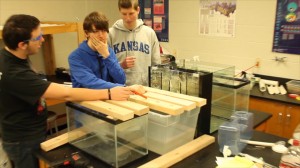Science at its Core
A full day of doing science for a full semester of investigation and community.
The Olathe Methanotroph Isolation and Identification research initiative is in its third year at Olathe East, and we are dealing with a new problem this year: fragmentation. When a program is new everyone is on the same page because it’s page one. Now I have both veterans of a couple years and newcomers that know nothing of our work. Procedures which used to be routine are now difficult because we graduated our experts, and suddenly our timeline isn’t known to everyone because we’ve finally been around long enough for turnover to become a problem.
Into this struggle stepped Ilya Tabakh. A GK12 fellow cooperating in our lab identified the fragmentation and communication problems I was also seeing and together we brainstormed ideas. We worked with students for a semester, but at winter break I had no new data and felt we needed to take big steps to get back on track. Together we crafted a full day field trip to spend together back at the basics of just doing the science. It was A LOT of work, but it was so worth the payoff that even without a program I think it would be worth replicating at other schools just for the value in the day itself.
Why are we here?
We started the day almost exactly like I start most of my labs in class: with a question. Are there methanotrophic microbes in the municipal water supplies in Olathe? We discussed the possible answers to the question (yes or no) and the implications of both. We then decided we wanted to develop, or redevelop, a procedure to answer the question. To fully understand the constraints in which we are working we turned to the primary literature.
This step was one that caused me the most anxiety because reading peer-reviewed literature is difficult and not always as glamorous as experimenting. I was amazed at how eagerly my students jumped into the papers I provided gathering procedure ideas and constraints. We did sticky notes on the board to compile our list of requirements for our experiment (media needs, toxicities and inhibitors, etc). We ultimately developed a concise flow chart that organized the four steps to our experiment and how to accomplish each phase.

Hitting the Literature
How do we do it?
After the initial research and discussion Ilya scheduled two speakers to talk with the students via Skype. Dr. Hill from NSF had a conversation with the students regarding the role of their kind of work within the national science community as a whole. Following Dr. Hill, Dr. DiSpirito from ISU spoke as one of the leading researchers on methanotrophs in the nation. The students used their work earlier in the morning to engage Dr. DiSpirito in a discussion of research practice related to growing and measuring methanotroph cultures. Dr. DiSpirito then offered criticism of our current procedure and apparatus (negative criticism is critical to quality scientific work, which I explained to the students beforehand).
The meetings were a great way to let the students know they are not alone in their work. In addition to further sparking their interest and developing a larger sense of community it also allowed them to see how their work in high school could translate to more in college and ultimately as a career. The scientific community has been incredibly supportive (heck, Dr. DiSpirito offered a tour and use of his lab if we could get up to Iowa) so all it really takes is an email or two to the relevant people in your field of interest to schedule speakers or collaborators of your own.
For what are we waiting?
Our speakers took our time into lunch: Chipotle – yum. Incidentally, they also are willing to support educational endeavors with donated food if you provide enough advance notice. We then spent the afternoon building apparatus, mixing media, and designing inoculation and incubation chambers. We had other students filming a documentary of the day’s activities. Several of my upper classmen also had independent research projects on which they were working. The afternoon was a time for doing, and watching the students work with purpose and excitement was one of the best feelings I’ve had yet as a teacher.
Our work during the first annual Core Research Day has set the stage for a much more productive and focused second semester of work. Students fully understand their responsibilities in the larger lab effort and how their contributions will lead to a dataset in the end. It was a lot of work to organize but it was worth the experience. It was so valuable that I think any science teacher would probably enjoy spending a full day with interested students doing science to answer a question. It felt like science, and really gets to the heart of what we try to do on a daily basis in our classroom. Sometimes I say to students, “If we could be in here all day we’d do [experiment].” It is refreshing to finally act that claim out.





